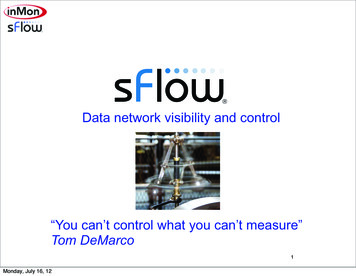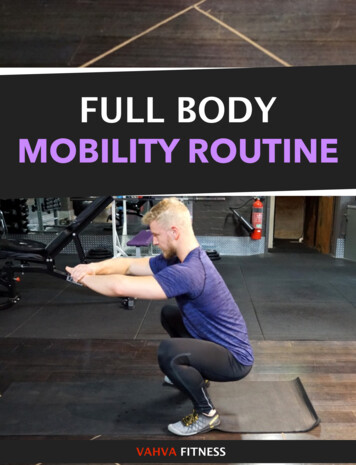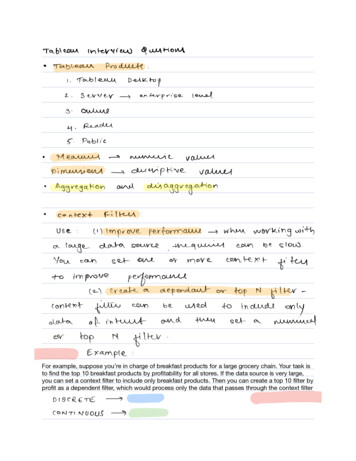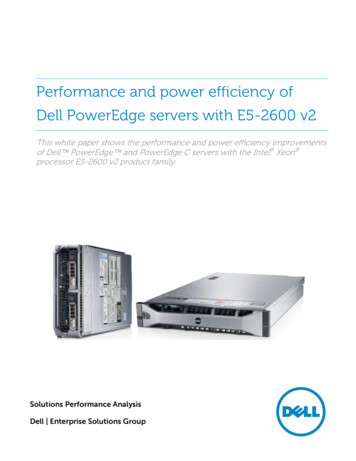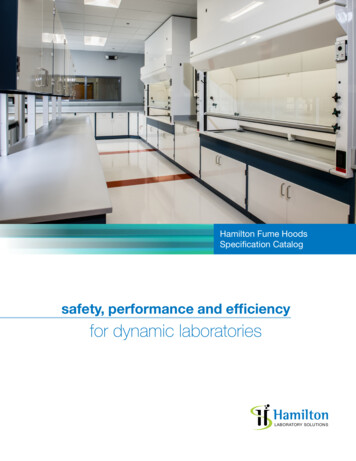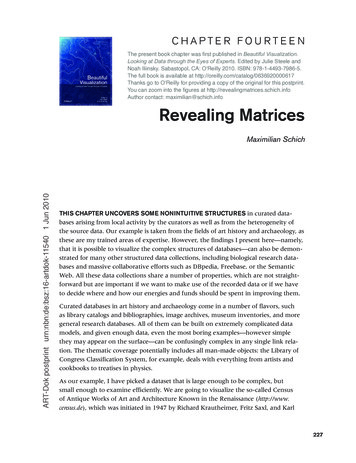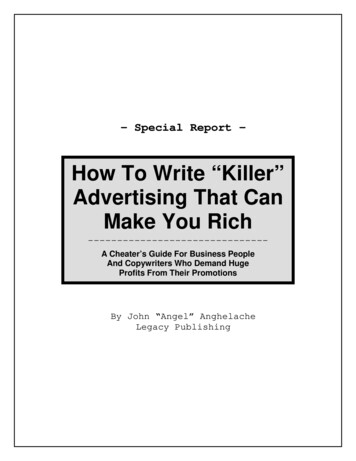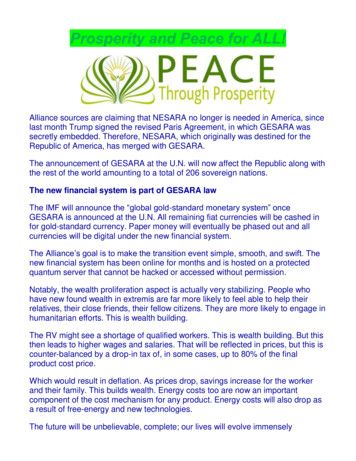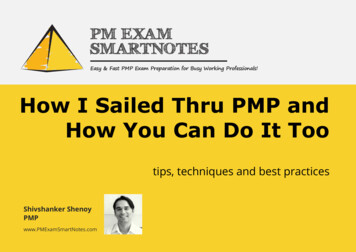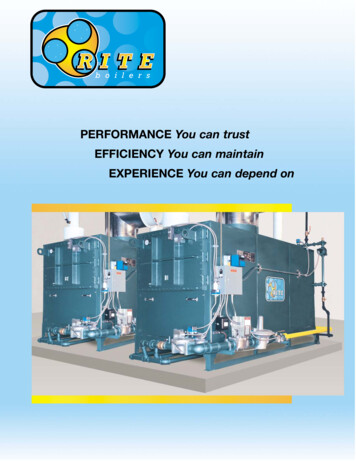
Transcription
PERFORMANCE You can trustEFFICIENCY You can maintainEXPERIENCE You can depend on
Firetube, Watertube, or Cast Iron?Copper Fin, Bent Tube or Straight Tube?These are some of the decisions facedwhen choosing a boiler. Making an intelligentchoice starts with asking the right questions:What are the basic design differences? Whatis the boiler’s efficiency when new and moreimportantly – can this efficiency be maintained?Which boiler will have the lowest operatingcost and the longest service life and why?SteamLocomotiveDid you know that some current designsgo back well over a hundred years? Today’sfiretube boilers, for example, are descendantsof the old steam powered locomotive boilersthat once crisscrossed America. As theindustrial and commercial boiler markets grewin the early part of the 20th Century, onenotable improvement over the firetube boilerwas the bent tube boiler. Because bent tubescould flex, they could withstand the “shock” ofcold feedwater better than firetubes. But coldfeedwater created another problem for boththese types of boilers: oxygen corrosion. Thishelped popularize cast iron boilers which hadbetter resistance to oxygen corrosion thansteel. However, cast iron’s low tensile strengthalso limited its use primarily to low pressurecommercial and residential applications.FiretubeBent TubeCast IronToday many of the challenges and assumptions that earlier boiler manufacturers faced nolonger exist. Steam traps, de-aerators, andwater treatment have largely eliminated coldfeedwater problems. The old “minimum squarefeet of heating surface” rule has shrunk from10 square feet per boiler horsepower in 1900to around 5 square feet by 1960. And steamboilers themselves have been largely replacedby water heating boilers for comfort heat andother low temperature process applications.But one very big problem for all boilers stillremains: SCALE.Also called “lime”, “mud”, or “sludge”,it occurs when dissolved solids in watersettle out in a boiler. Making matters worse,these solids tend to drop out of suspensionand plate onto the hottest heat transfersurfaces, forming a cement–like barrier ofinsulation that leads to overheated metalsurfaces and ultimately metal fatigue. It’s thefamiliar process that ends the life of mostresidential hot water heaters.Copper Fin Tube
ENERGY LOSS DUE TO SCALE DEPOSITSADDITIONAL FUEL REQUIRED DUE TO SCALEFuel Loss % of Total UseScaleThicknessin InchesScale 1/50 in. thick approximately 5% additional fuel requiredScale type“Normal”High IronScale 1/25 in. thick approximately 10% additional fuel requiredIron ��–1/163.96.2–––Scale 1/16 in. thick approximately 15% additional fuel requiredScale 1/8 in. thick approximately 30% additional fuel requiredScale 1/4 in. thick approximately 66% additional fuel requiredA BOILER TUBE SHOWING EXTRAFUEL REQUIRED DUE TO SCALEOF VARIOUS THICKNESSES.Scale 1/2 in. thick approximately 150% additional fuel requiredSource: Cooper ToolsSource: National Institute of Standards and TechnologyAs the charts show, this widely recognizedproblem has a devastating effect on boilerefficiency and operating costs. No matterhow impressive a new boiler’s start-upefficiency is, scale can quickly knock itdown—driving up fuel costs until major boilerrepairs or replacement are unavoidable. So,how easy is it to keep some common boilerdesigns clean and operating at peak efficiency year after year? Let’s take a look:You’ll find it’s virtually impossible for aperson to get inside a firetube boiler to cleanout scale. Cast iron boilers offer no access.The “U” bends in bent tube boilers not onlycreate natural traps for scale to collect, butcompound this problem by keeping scalehidden from view as well. And copper fintubeboiler manufacturers require an exact flowrate of 7 feet per second if you want to insuretheir tubes from scaling or eroding. “Well”,you ask, “Did anybody design a heavy-dutyboiler with fast and effective watersideaccess?”Shortly after World War II, a new type ofboiler appeared on the market. With a heatexchanger consisting of two headers withremovable endplates and a connecting bankof inclined “see-through” tubes, this boilerwas designed to remove scale with ease. TheHorizontal Inclined Watertube Boiler, as itcame to be called, proved to have many otheradvantages as well.Firetube(Scale)Cast Iron(Scale)Bent Tube(Scale)Copper Fin Tube(Scale)(Erosion)Rite Engineering began manufacturingthis type of boiler in 1952. Fifty years andover 25,000 boilers later, Rite is morecommitted than ever to engineering andpackaging performance you can trust andefficiency you can maintain.
6758910432114WATER BOILERADVANTAGES 11-300 Boiler Horsepower M.A.W.P. to 160 PSI T to 100 F Supply Water to 240 F No minimum flow rate or flow switch required No “runaround” pump required P less than 3’ head 25 Year Thermal Shock and Tube Erosion Warranty 80% and 83% maintainable efficiency models available Atmospheric or Power Burner Fired1.2.3.4.1112Front firebox inspection viewport.Removable front and rear headplates. Available withhinges for weightless operation.2” See-through tubes for quick and easy inspection andmaintainance. Tubing is non-proprietary and widelyavailable from competitive sources. Replacement costs aremany times less than proprietary bent tubes.Headplate flanges are drilled and tapped for smooth gasketsurfaces. No flange welded studs to corrode away orCutaway of a Rite 7 MillionBTU Hot Water BoilerPower burner firedinterfere with hinged headplates or flange clean-up.Hot water supply connections are ANSI 150# flanged over 2”.Round stack outlet with built-in stack supports. Single stacksavailable on Atmospheric fired boilers up to 7500 MBH input.7. ASME safety relief valve.8. Hot water return connection is standard on top for easierfield piping and to avoid blocking the rear headplate.9. Float or probe type low water cut-off.10. Air elimination fitting.5.6.232221Rite 100 HorsepowerHigh Pressure Steam Boiler(Power burner removedfor clarity)HIGH PRESSURE STEAM &HIGH TEMPERATURE HOTWATER BOILER ADVANTAGES 9.5 - 250 Boiler HorsepowerM.A.W.P. to 325 PSITemperatures to 400 FSteams in about 5 minutes from a cold start99% Steam Quality under steady loadconditionsNo Steam Baffles or Separators requiredExtra Thick Shell and Tubesheet resistcorrosionHinged Headplates available for easywaterside accessNo Handhole or Manhole Assemblies25 Year Thermal Shock WarrantyNominal 80% maintainable efficiencyAtmospheric or Power Burner Fired13
161715LOW PRESSURESTEAM BOILERADVANTAGES19181120Cutaway of a Rite 2.5 Million BTULow Pressure Steam BoilerAtmospheric burner fired11. Floating head assembly relieves stress causedby “thermal shock”.12. Rear firebox inspection viewport.13. Refractory and insulation.14. Firebox access door.15. ASME rated pop safety valve.16. Primary low water cut-off probe.17. Steam supply.18. Steam column featuring self-indicating low19.20.21.22.23.24.THE KEY TO GOOD HEAT TRANSFER 11-300 Boiler HorsepowerM.A.W.P. 15 PSISteams in about 5 minutes from acold start99% Steam Quality under steadyload conditionsNo Steam Baffles or SeparatorsrequiredThick Shell and Tubesheetresist corrosionHinged Headplates available forcomplete and easy waterside access25 Year Thermal Shock WarrantyAtmospheric or Power Burner FiredNominal 80% maintainable efficiencywater cut-off and pump control probes.Steam final pass “superheat” tubes.Heavy duty cast iron upshot burners provide whisper quiet,maintenance free operation.Waterside inspection/blowdown connection.Surface blowdown connection.Draft gauge.Hinged headplate.24Our self-baffled tube bundle keepshot combustion gasses pinballingthrough the heat exchanger to reducelaminar gas flow and maximize heattransfer efficiency.Rite 100 Horsepower High PressureSteam Boiler with Hinged Headplates(Power burner removed for clarity)
“Thermal shock” can happen to any boiler when pressure vessel metal expands (heats up) or contracts (cools down).This is caused by normal burner on-off cycling or by inadvertentslugs of cold feedwater or stratification of varying water temperatures in the vessel itself. Severe mechanical stress canoccur if parts of the pressure vessel expand and contract atdifferent rates or if these movements are restrained. Dependingon the type of boiler, the end result can range from tubes loosening or warping, tube-sheet-to-shell weld cracks, cast ironcracking or broken stay-rods.Fig. 1 Angle irons with oval slots are pairedwith angle irons with round holes.Because the coefficient of expansion of metal increaseswith temperature, a boiler with clean heat transfer surfaces, suchas the tubes, will experience less stress than a similarly constructed boiler that is scaled up. Furthermore, boilers that aredesigned without expansion joints or made from brittle metalsare more susceptible to stress than those which allow for movement and are manufactured using more ductile material.So what did the engineers at RITE do to outsmart theFig. 2 View showing oval holes over round holeswith one of the keeper bolts removed.forces of thermal shock? They began by designing a pressurevessel that promoted turbulent water flow and natural circula-HEADER BOXtion in order to prevent stratification. Secondly, by limiting theforces of expansion and contraction to a single uniform tubebundle, they eliminated the rigidity and opposing stresses thatwelded shells, Morison (furnace) tubes and stay-rods imposeon other types of boilers. Third, by specifying that the pressurevessel be made of low carbon steel, they made it far more ductile and able to survive sudden pressure and temperature changesthan boilers made from cast metal. And by making the tubesstraight and cleanable, they made it easy to minimize the expansion rate of the heating surfaces too.“But with straight tubes, how does RITE accommo-LEGFig. 3 Lineal slide assembly connecting leg toheader using keeper bolts and backweldednuts. Bearing surfaces are lubricated.date normal tube expansion and contraction?” Good question.After all, a clean steel tube 12 feet long (the longest we use) willgrow by about 1/4 inch in a hot water boiler when going from 60 to 200 F . The following photographs illustrate our engineers’deceptively simple solution: An expansion joint consisting of apair of heavy duty lineal slides that allow one of the headerboxes to move freely in either direction as the tubes expandand contract. How effective is it? Our normally conservativeengineers have written a most liberal 25 year Thermal ShockWarranty around it.Based on 100 F average tube temperature above the saturationtemperature, coefficient of expansion formula for steel tubes is:.000007 x Length (144”) x T (240 F) .2419”.Fig. 4 View of tubes and rear header box showingright side lineal slide assembly.
L I G H T E R . . . E A S I E R . . . F A S T E RCONTRACTORS: Do tough access replacement boiler jobs bring on your disappearing act? If so, then maybe it’stime to consider a less frightening alternative. For every contractor that’s had to string a boiler through a window, downa stairwell, around a corner, or into an elevator -- we would like to offer a little magic of our own:The RITE Take-A-Part. What makes ourdesign better? Lighter weight parts for one,because there are no heavy cast ironsections. Easier because there’s no weldingrequired. Faster because you take it apart onlyas far as necessary. And simpler because theRemovable Hardware(shown in red)RITE T.A.P.s ship assembledTool Rental KitPARTIAL TAKE-A-PARTparts arrive assembled - with instructions - soyou’ll see exactly how they go together.We can help you choose betweenFULL TAKE-A-PARTour Partial and Full Take-A-Partboilers by providing dimensions andweights of the largest parts. Needtube rolling tools for our FullTake-A-Parts? Our tool rental kit(shown above) ships UPS.Can we handle special requests? YouLargest Piece: 50 Horsepower Boiler Pressure Vessel going through 34’’ wide door(From RITE Take-A-Part Video)bet. We recently shipped (3) two-hun-Largest Piece: 90 Horsepower SteamHeader going through 34’’ wide door(From RITE Take-A-Part Video)dred horsepower steam boilers to aschool in Chicago. At over 9’ tall theboilers would not fit through the access doors unless they could beSide View of Pressure Vessel Section above“sawed in half”. With a few minorTubes ship loose with boilermodifications to our Partial TakeA-Part design, we were able to deliver boilers that the contractor couldknock down and rebuild in hours -not days. Would you like to knowmore? Ask your representative for aTubes installed at factory,No ASME hydrotest requiredfree copy of our Take-A-Part video.Tubes installed by contractor,ASME hydrotest is required
BEYOND1T2In most endeavors it is a wellknown fact that the BASICSmust be mastered beforesomething special can emerge.The same can be said about 12 PPM LOW NOx DUALFUEL FIRED INSULATED HEADPLATES SKID MOUNTED PACKAGEDSTEAM SYSTEM FOR OUTDOORSboilers. The flexibility of ourdesign promotes one of the67broadest ranges in the industry.To go from low and hightemperature water to low andhigh pressure steam, you’vegot to have a proven design.And one with plenty of muscle SIDEARM HEAT EXCHANGER EXPANSION TANK BLOWDOWN TANK42” DIAMETERbehind it. (Which could come inhandy the next time your boiler1112undergoes a little mistreatment).All of which brings us to the“specials”, “options”, “extras”, orwhatever else you want to callthem. Truth is, they are all prettybasic to us. SOOT SCRAPER (SIMPLEPUSH/ PULL OPERATION) CONDENSATE RETURNFEEDWATER TANK
HEBASICS354 30 PPM LOW NOx WEATHERPROOF8 CERAMIC FIBER FIREBOX9 SEWAGE TREATMENT PLANT BOILER(DIGESTER / NATURAL GAS FIRED)1310 HINGED HEADPLATE HANDHOLE BOILER RUN-AROUND BLENDPUMP FOR LIMITED LOWTEMPERATURE RETURN1514 WEATHERPROOF BOILER EXPANSION TANK (FRONT) INDUCED DRAFT FAN (REAR) HINGED HEADPLATES STAINLESS STEEL MIRRORFINISH JACKET 350 F HIGH TEMPERATURE HOTWATER BOILER (ASME SECTION 1) B 31.1 ASME PRESSURE PIPING
ENGINEERING HELPFUL HINTS & FORMULASHEATING LOAD EQUATIONSMETRIC CONVERSIONS KiloPascals pounds6.9 Kilowatts x 1.341 Boiler Horsepower Kilowatts x 3413 BTU Liters x .2641 Gallons Degrees Centigrade (F - 32) x .5555 Degrees Fahrenheit (C x 1.8) 32 Hot Water heating: BTU output 500 x T x GPM Divide BTU output by boiler efficiency (ie: .8 for 80%) to get input Pounds per Hour Steam Required to heat water GPM x T x 1.12 PPH Steam Required to heat air with steam coil CFM AIR x T800 PPH Steam Required for humidification: www.riteboiler.com, click engineering. FUEL VALUESMISCELLANEOUS 1 Boiler Horsepower 34.5 PPH Steam 34,000 BTUH Output 140 sq. ft. E.D.R 1 PSI 28’’ W.C. (Water Column) 2’’ Hg (Mercury) 16 ounces 1 gallon propane 36.5 cu. ft. 4.25 lbs. PSI x 2.31 feet of head 1 gallon #2 oil (diesel) 140,000 BTU Condensation can quickly ruin a hot water boiler. The #1 cause ispersistent low return water temperature. A good system design canprevent it, but first you must know the boiler’s minimumrecommended return water temperature, for RITE, it’s 135 F.Next, make sure the boiler(s) selected can easily handle the load.For systems designed with a fixed operating temperature, the Tshould never return water less than 135 . If reset is required (1)program it so the return can’t fall below 135 , or (2) use a 3-wayvalve in the piping system to bypass cooler water around the boiler,or (3) use a primary-secondary loop. When boiler is used for humidification control, do not turn theboiler or pump off at night if the chilled water to the VAV boxes orair handler will indirectly cool the boiler loop water. Never run chilled water through a boiler, even in summer. Keep cold start-ups to a minimum during heating season.Cooling a system down only to reheat it again a short time laterFor natural & LP gas fired boilers. When using high sulfur fuels, theminimum return must also increase. For #2 oil: 155 F minimum return. Fordigester (sewage) gas, 190 F minimum return.% ByVolume10%20%30%40%50%FreezeProtectionDown to F 25 26 15 19 3 9-12.5 - 4-36-23 Propylene Dow “Dowfrost” At 20 T ORAt 1 FootPer SecondFlow Through TubesDerate Output By:NANA1.2%1.8%2.6%NANA1.4%2.2%3.6%Altitude Derations:ATMOSPHERIC BOILERS: Up to 2000’ above sea level,no output deration. Starting at 2500’, derate 10%, @ 3000’derate 12%, @ 4000’ derate 16%, and so on.POWER BURNER FIRED BOILERS: Up to 2000’, noderation. Starting at 2500’, derate 2%, @ 3000’ derate 4%,@ 4000’ derate 8% and so on.Note: Glycol & Altitude derations are not cumulative. Use only the larger of the two figures.For complete engineering details about our Water Source Heat Pump packages aswell as all our other piping diagrams, visit www.riteboiler.com, click engineering.Looking for something really hot but don’t want to go with thermal oilfluids or high pressure steam? Then try our high temperature hot water boilersinstead. Environmentally safer than thermal oil and more energy efficient than steam, they’reperfect for large campus type heating systems and high heat process loads.See photo #15 on the preceding page (one of four sold to Honeywell) and contact us tolearn more about why HTHW systems are fast becoming the preferred choice of manyconsulting engineers.System Do’s & Don’ts Ethylene Glycol is highly toxic if ingested. Propylene Glycol is generally accepted as safer but still not intended forhuman consumption. Select a temperature rating at least 5 F lower thanexpected lowest ambient temperature.nets very little energy savings. To conserve energy consider (1) anight set-back control for 135 F return (2) An automatic stack(closing) damper (3) Turning off the secondary system pump(s)only, not the primary pump(s) or boiler(s) (4) Turning the systempump(s) and boiler(s) off over long weekends only. For 60 - 90 F water source heat pump systems, we cansupply the piping arrangement shown below on any of our hotwater boilers.Hot Stuff 250 - 400 F Ethyelene Dowtherm SR-1 Through BoilerDerate OutputBy:5%11%17%21%25% 1 Cubic foot natural gas 1,000 BTU 1 Cubic foot L.P. gas (propane) 2500 BTU 1 gallon of water 8.3 poundsGlycol Derations For Rite Boiler 1 Therm 100,000 BTU Do specify 15-25 PSI cushion over the equivalent saturated steam pressure for hot watersystems operating over 212 F. Do specify the boiler relief valve setting be at least 15% or more above the system’snormal operating pressure. Generally speaking, the larger the gap the better. Do specify the pH in hot water systems at between 9 and 10 and for steam between 10and 11. Don’t specify pumping directly into hot water boilers (unless you’ve factored in the pumphead pressure to the overall operating pressure and are 15% or more under the R.V. setting.Don’t specify make-up air or exhaust fans in the boiler room without making provisionsfor potential positive or negative pressures.Don’t specify non-return (stop-check) valves on low pressure steam boilers in battery(multiple units feeding a common header). When sizing non-return valves for highpressure steam boilers in battery - size to maintain 4000-5000 feet per minute velocity toprevent water carryover.
LEADERS IN LOW NOx TECHNOLOGYIn 1989, we were one of the first to provide Low NOxemission boilers in California. As Low NOx regulations havespread, the fever surrounding this new technology has spawnedmore than its share of freshly minted products to meet thedemand. Unfortunately for many end users, some Low NOxburner systems have proved costly to maintain under long-termboiler operating conditions. Our approach to Low NOx is toprovide trouble-free Low NOx burners that will benefit both theenvironment and our customers for many years to come.RITE 30PPM Low NOx Boiler shown above.20PPM & 12PPM Low NOx models also available.HYDRAULIC SAFETYWhat is hydraulic safety? It’s b
tions that earlier boiler manufacturers faced no longer exist. Steam traps, de-aerators, and water treatment have largely eliminated cold feedwater problems. The old “minimum square feet of heating surface” rule has shrunk from 10 square feet per boiler horsepower in 1900 to around 5 square feet by 1960. And steam
